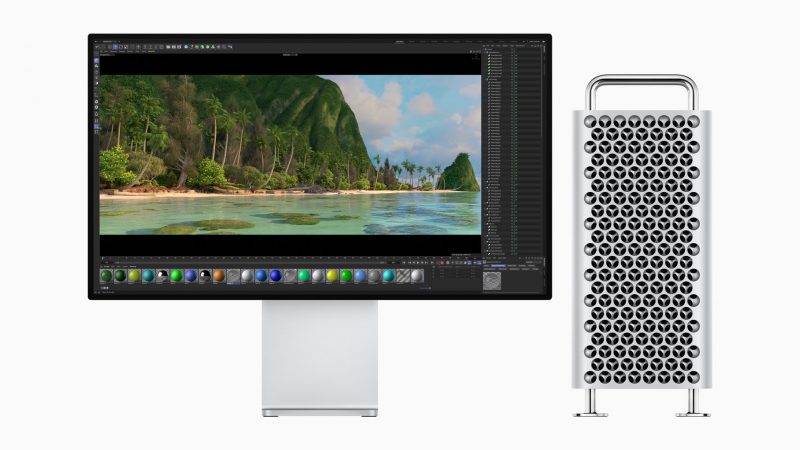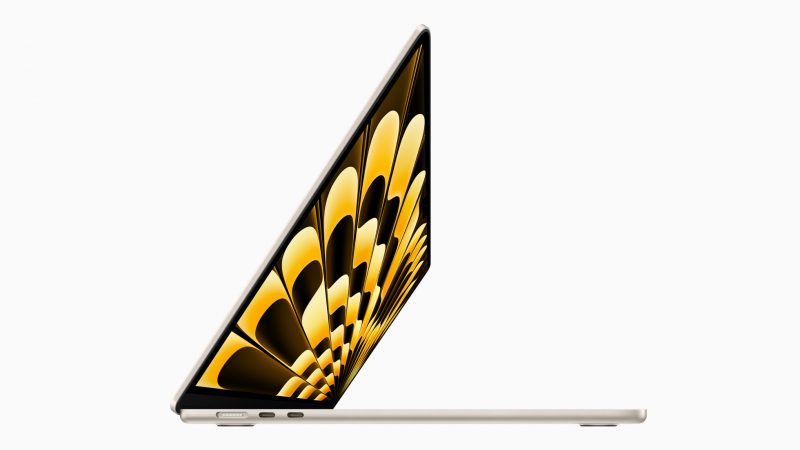 APPS
APPS
 APPS
APPS
 APPS
APPS
Apple Inc. unveiled an upgrade to its M2 family of chips with the M2 Ultra during its WWDC 2023 developer conference today that the company is introducing to its new Mac Studio and Mac Pro lineup to deliver professional-level performance.
The company also announced a new 15-inch MacBook Air featuring an M2 chip and OS updates including macOS Sonoma and iOS 17, which opens up a bevy of new features for iPhone users across communication apps such as Phone, FaceTime and Messages. Finally the release of macOS Sonoma brings widgets onto the desktop and updates to productivity and web browsing.
Just like the M1 Ultra before it, the M2 Ultra is the completion of M2 family that fuses two M2 Max chips together using Apple’s UltraFusion technology to bridge two dies together into one system on a chip design, connecting two M2 Max dies together to double the performance.
The M2 Ultra is a five-nanometer process and consists of 134 billion transistors, 20 billion more than the M1 Ultra. After fusion, its architecture holds 192 gigabytes of memory capacity, which itself is 50% larger than the M1 Ultra and features 800 gigabytes per second of memory bandwidth, twice that of the M2 Max.
“M2 Ultra delivers astonishing performance and capabilities for our pro users’ most demanding workflows while maintaining Apple silicon’s industry-leading power efficiency,” said Johny Srouji, Apple’s senior vice president of hardware technologies.
The 24-core central processing unit of the M2 Ultra consists of 16 high-performance cores and eight high-efficiency cores, making it capable of delivering 20% faster performance than the M1 Ultra. For a performance comparison, users of Mac Studio powered by the M2 Ultra with DaVinci Resolve, the video processing software, could get workloads done 50% faster than with the previous generation chip. The graphics processing unit can be configured with 60 or 76 cores as well. The chip also features a 32-core Neural Engine, capable of processing up to 31.6 trillion operations per second, making it a powerful workhorse for training artificial intelligence models.
The chip is now available in the lineup of Apple’s computers including the new Mac Studio and Mac Pro.

The Mac Studio and Mac Pro are two of the most powerful Macs ever designed by Apple and aimed and professional users who need computers to process extreme workloads such as studio-quality video or operate workstation video cards. The addition of the M2 Max and M2 Ultra aligns well with these purposes and these new chips as part of the Mac Studio and Pro lineups are part of these announcements.
“Mac Studio has been a breakthrough for pros everywhere, and it’s at the heart of hundreds of thousands of home and pro studios across the world,” said John Ternus, Apple’s senior vice president of hardware engineering. “Today, it gets even better with M2 Max and the new M2 Ultra, featuring even more performance and enhanced connectivity.”
The new Mac Studio provides an enhanced array of connectivity for professionals including higher-bandwidth HDMI that enables up to 8K resolution and 240Hz frame rates for monitors. With the new M2 Ultra chip included, Mac Studio machines can support up to six Pro Display monitors and can drive over 100 million pixels at once – which will give professionals a lot of screen real estate to spread their video and graphics work over.
On the back, Mac Studio now includes four Thunderbolt 4 ports, a 10Gb Ethernet port, an enhanced HDMI port, and two USB-A ports. On the front, there are two USB-C ports and an SD card slot. Wireless connectivity includes Wi-Fi 6E and Bluetooth 5.3.
Mac Studio starts at $1,999 for the M2 Max model and is available for order now and will begin arriving for customers on June 13. The M2 Ultra model will cost $3,999.
The Mac Pro brings both versatility and power to the Mac lineup, now with the M2 Ultra chip. It has the additional availability of PCIe expansion slots, meaning that users can add cards to the computer to quickly keep up with whatever workflows they need including additional audio cards, video cards or whatever they might need to customize their system.
Originally, Intel-based Mac Pros needed to use a PCIe Afterburner card in order to keep up with heavy video processing workloads. Now every Mac Pro has that same performance built-in with the M2 Ultra chip comparable to seven Afterburner cards.
The Mac Pro features six open expansion slots that support gen 4 PCIe, which is 2x faster than before. This will allow audio engineers who need extra signal processing cards, or video professionals who need serial digital interfaces for extra cameras and monitors, or users who need extra networking and storage. The underlying customizability and expandability of the Mac Pro make it extremely versatile.
As for connecting other devices, the Mac Pro has eight built-in Thunderbolt 4 ports – six on the back and two on top. It can support up to six Pro Display monitors. It also includes three USB-A ports, two high-bandwidth HDMI ports that support up to 8K resolution and up to 240K Hz frame rates, two 10 gigabit Ethernet ports and a headphone jack that supports high-impedance headphones.
The Mac Pro is available in both tower and rack-mounted form factors and starts at $6,999. It can be ordered today and will begin shipping on June 13.

Apple announced a new MacBook Air that brings the power of the M2 chip to these thin and lightweight laptops along with an expanded 15-inch form factor.
The new MacBook Air has a 15.3-inch Liquid Retina display that is capable of up to 500 nits of brightness and supports up to 1 billion colors. Fitting with its name and the fundamentals of its line, the new 15-inch MacBook Air is also ultra-thin coming in at only 11.5mm, which Apple claims makes it the world’s thinnest 15-inch laptop. It also weighs only 3.3 pounds.
For charging, it features MagSafe, which allows for easy charging with a magnetic attachment so that if it’s yanked off the product it won’t get damaged. Two Thunderbolt ports are available for connecting accessories and up to a 6K external display and a 3.5mm headphone jack for headphones.
At the top of the screen, the Air features a 1080p FaceTime HD camera designed to keep the user in focus and a three-mic array to maintain clear audio quality with beamforming algorithms.
A six-speaker sound system includes two tweeters and two sets of force-canceling woofers. It uses spatial audio using Dolby Atmos in order to deliver immersive sound for concert music and movie experiences even from an extremely thin form factor.
The 15-inch MacBook Air starts at $1,299 and is available for order today and arrives at stores and ships to customers beginning June 13.

Apple announced iOS 17, a major release to the mobile operating system that updated communications for Phone, FaceTime, Messages and artificial intelligence behind autocorrect and predictive text. Alongside that, the company also announced macOS Sonoma, the next desktop operating system.
“With iOS 17, we’ve made iPhone more personal and intuitive by deeply considering the features we all rely on every day,” said Craig Federighi, Apple’s senior vice president of software engineering. “Phone, FaceTime and Messages are central to how we communicate, and this release is packed with updates we think our users are going to love.”
The addition of Contact Posters will enable users to add photos and change how their names are displayed on incoming calls, allowing them to customize colors and fonts. This will also be available for third-party calling apps.
New Live Voicemail will give users the ability to see real-time transcription as voicemail is being left. As a result, if someone calls and is leaving a voicemail, they can read it and decide if they want to pick up. The transcription occurs entirely on the device using the neural engine and remains entirely private. FaceTime has been updated so that if the person isn’t available people can now leave a video message that they can pick up later.
Messages received a safety feature that allows users to check in with friends or family. Once a user initiates a “Check In,” it will automatically inform the other user that they have arrived at a designated location. If they don’t make progress toward the location, useful information will be temporarily shared with the contact such as device location, battery level and service status.
Users can also now create stickers by lifting subjects out of photos, including animated stickers from moving photos. These stickers can then be easily stuck into a user’s messages timeline like any other sticker in Messages.
Using the neural engine in the phone, autocorrect is getting comprehensive improvements with a transformer language model – which is a state-of-the-art, on-device machine-learning language model for word prediction. It will be used to improve accuracy based on the way that users type so that it gets used to how they type and stops correcting their quirks. The model also received updates so that it can support typing and sentence-level autocorrections to fix more types of grammatical mistakes. And users will now receive predictive text recommendations inline as they type, allowing them to add words or complete sentences as easily as by tapping the spacebar.
MacOS Sonoma will be arriving this fall and will add new features and productivity tools for users on Mac affecting widgets, video conferencing and web browsing.
Widgets on the Mac provide a useful way to view information and interact with apps. In the past they were accessible through a shelf from the side, now they can be moved onto the desktop itself and interact with them in one click. When a user interacts with apps, they also become transparent so that they aren’t distracting. Users don’t need to have an app installed on their Mac in order to have access to widgets on their Mac, they could have them installed on a nearby iPhone that they own and access a widget.
New dynamic videoconferencing features in Sonoma include the ability to put a visual of yourself onto a presentation. This can be done either inside a bubble or with the background cut out. This makes it much easier to include yourself when presenting something such as screen sharing, a video or any other content.
For web browsing, Safari received Profiles that allow users to split up their browsing experience between multiple topics or projects allowing them to separate them into their own segments. They can also turn web pages into “Web Apps” that can be pulled into the hot bar on the Mac and treated just like any other app, which provides rapid access to favorite sites.
THANK YOU